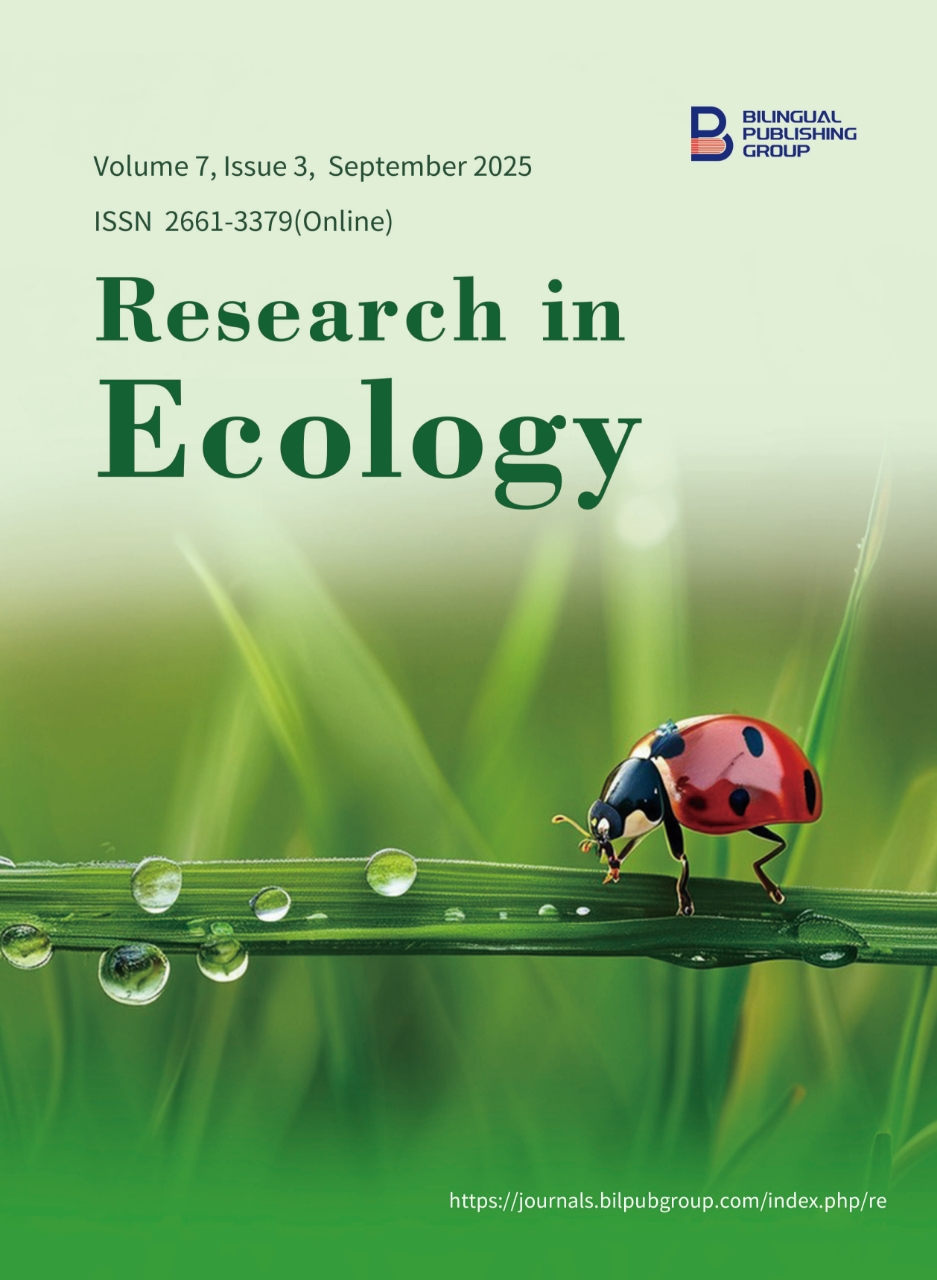
Prospects of Algolization of Rice Fields in Osh Oblast
DOI:
https://doi.org/10.30564/re.v7i3.9891Abstract
The article discusses the prospects of using algae in the soil—to improve the fertility of rice fields in the Osh oblast of Kyrgyzstan. The authors note that the Fergana Valley, where Osh oblast is located, is an important rice-growing region, and there are currently plans to expand rice fields. In this regard, the study of methods to increase rice yields, such as algolization, is of particular relevance. The article emphasizes that rice fields are unique aquatic ecosystems where microorganisms, especially algae, play an important role. Algae, particularly blue-green algae (cyanobacteria), are capable of fixing nitrogen from the air and enrich the soil with it, which is especially important for rice, which needs nitrogen for growth. The algolization method helps to improve soil structure, reduce the need for mineral fertilizers, control weeds and is an environmentally friendly method of fertility improvement. The authors provide data on the species composition of cyanobacteria found in rice fields in Osh oblast, noting the predominance of Chroococcus and Hormogonium forms. They also indicate seasonal fluctuations in algae abundance associated with climatic conditions. In conclusion, the authors highlight the promising application of algolization in rice farming in Osh oblast and the need for further research to identify the most effective algal species and develop optimal methods of their application.
Keywords:
Algolization; Rice Fields; Osh Region; Algae; Сyanobacteria; Nitrogen Fixation; Soil Fertility; Rice YieldReferences
[1] National Statistical Committee of the Kyrgyz Republic, n.d. Agriculture. Available from: https://stat.gov.kg/ru/statistics/selskoe-hozyajstvo/ (cited 23 August 2024).
[2] United Nations Development Programme (UNDP), n.d. Sustainable Development Goals. Available from: https://www.undp.org/sustainable-development-goals (cited 15.01.2020).
[3] United Nations, 2015. Agenda for Sustainable Development. Available from: https://www.un.org/sustainabledevelopment/ru/about/development-agenda/ (cited 14 March 2023).
[4] Sonagnon, O.T., Zacharie, S., Adekunle, D.M., et al., 2024. Integrating of the domestic goat into the rice-fish coculture systems: Rice paddy yield, diet, growth parameters, and intestine microbiota of common carp Cyprinus carpio (Linnaeus, 1758). Aquaculture. 593, 741255. DOI: https://doi.org/10.1016/j.aquaculture.2024.741255
[5] Bashir, M.A., Yang, X., Wang, H., et al., 2025. Integrated rice-crab co-culture system shows capability to reduce greenhouse gases emission and global warming potential. Aquaculture. 598, 742047. DOI: https://doi.org/10.1016/j.aquaculture.2024.742047
[6] Pekkoh, J., Thurakit, T., Ruangrit, K., et al., 2024. Co-bioaugmentation with microalgae and probiotic bacteria: Sustainable solutions for upcycling of aquaculture wastewater and agricultural residues into microbial-rice bran complexes. Environmental Research. 261, 119760. DOI: https://doi.org/10.1016/j.envres.2024.119760
[7] Kuchkarova, M.A., 1980. Application of blue-green algae in rice farming in Khorezm province. In Proceedings of the Cultivation and application of microalgae in national economy, Tashkent, Uzbekistan; pp. 137–140.
[8] Zayadan, B.K., Zhubanova, A.A., 2002. Prospects for the use of microalgae in agriculture. In Proceedings of the Materials of the International Scientific and Practical Conference “Scientific support of sustainable development of agro-industrial complex of the Republic of Kazakhstan, Siberia, Mongolia and the Republic of Belarus”, Almaty, Kazakhstan; p. 228.
[9] Kuzyakhmetov, G.G., Khaibullina, E.F., 2008. Biotechnology of microalgae in agriculture. In Proceedings of the Problems of modern algology: Materials of the All-Russian School-Seminar, Ufa, Russia, 7–9 October 2008; pp. 71–74.
[10] Dobrozhan, S.N., Shalaru, V.V., Shalaru, V.M., et al., 2014. Use of some species of blue-green nitrogen-fixing algae as biological fertilizer. Algology. 24(3), 426–429.
[11] Karimov, B., Boronbaeva, A., Dursunbaeva, A., et al., 2025. Cultivation of promising aquatic plant species for sustainable development of Central Asian biodiversity. E3S Web of Conferences. 614, 04010. DOI: https://doi.org/10.1051/e3sconf/202561404010
[12] Zhang, Y., Ding, S., Xue, X., et al., 2025. Combined application of nitrogen-fixing cyanobacteria enhances rice growth and nutritional quality in saline environments. Algal Research. 89, 104061. DOI: https://doi.org/10.1016/j.algal.2025.104061
[13] Li, S., Huang, W., Peng, C., et al., 2025. Enhancement of rice production and soil carbon sequestration utilizing nitrogen-fixing cyanobacteria. Applied Soil Ecology. 207, 105940. DOI: https://doi.org/10.1016/j.apsoil.2025.105940
[14] Muzafarov, A.M., Taubaev, T.T., 1984. Cultivation and application of microalgae. Fan Uzbek SSR: Tashkent, Uzbekistan. pp. 1–132.
[15] Rayanee, C., Paramasivan, B., 2023. Role of microalgae in agriculture. In: Sangeetha, J., Codreanu, S., Thangadurai, D. (eds.). Microalgal Biotechnology: Bioprospecting Microalgae for Functional Metabolites towards Commercial and Sustainable Applications. Apple Academic Press: Cambridge, MA, USA. pp. 183–204.
[16] Ignatov, V.V., 1998. Biological nitrogen fixation and nitrogen fixers. Soros Educational Journal. 9, 28–33.
[17] Mishra, U., Choudhary, K.K., Pabbi, S., et al., 2005. Influence of blue green algae and Azolla inoculation on specific soil enzymes under paddy cultivation. Asian Journal of Microbiology, Biotechnology and Environmental Sciences. 7(1), 9–12.
[18] Boronbaeva, A., Karimov, B., Attokurov, K., et al., 2024. Algae as indicators of water quality based on the example of the Kugart River and their seasonal changes. E3S Web of Conferences. 537, 05008. DOI: https://doi.org/10.1051/e3sconf/202453705008
[19] Abinandan, S., Subashchandrabose, S.R., Venkateswarlu, K., et al., 2019. Soil microalgae and cyanobacteria: the biotechnological potential in the maintenance of soil fertility and health. Critical Reviews in Biotechnology. 39(8), 981–998. DOI: https://doi.org/10.1080/07388551.2019.1654972
[20] Deviram, G., Muthukumar, C., Arul, A.D., et al., 2019. Role of cyanobacteria in agricultural and industrial sectors: an outlook on economically important byproducts. Applied Microbiology and Biotechnology. 103, 4709–4721. DOI: https://doi.org/10.1007/s00253-019-09811-1
[21] Dwiwanti, S., Rudi, H., Arifin, T., et al., 2025. Potential of Cyanobacteria as biological agents to improve sweet corn (Zea mays saccharate) germination and growth. BIO Web of Conferences. 155, 01011. DOI: https://doi.org/10.1051/bioconf/202515501011
[22] Wu, L., Dong, J., Song, J., et al., 2025. The nitrogen fixation characteristics of terrestrial nitrogen-fixing cyanobacteria and their role in promoting rice growth. Agronomy. 15(1), 62. DOI: https://doi.org/10.3390/agronomy15010062
[23] Antipchuk, A.F., 1990. Relationship between indices of photoassimilatory activity of leguminous plants and their symbiotic nitrogen fixation. Microbiological Journal. 52(6), 59–63.
[24] Kots'y, S.Y., Morgun, V.V., Patyka, V.F., et al., 2010. Biological Nitrogen Fixation. Bobovorizobial Symbiosis. Vol. 1. Logos: Kiev, Ukraine. pp. 1–508.
[25] Pankratova, E.M., Zyablykh, R.Yu.A., Kovina, A.L., et al., 2014. Construction of microbial cultures based on the blue-green alga Nostoc paludosum. Algologia. 14(4), 445–458.
[26] Yadav, R., Kumar, M., Tomar, R.S., 2024. Cyanobacteria based nanoformulation of biogenic CuO nanoparticles for plant growth promotion of rice under hydroponics conditions. Current Microbiology. 81(5), 118. DOI: https://doi.org/10.1007/s00284-024-03619-7
[27] Santosh, B., Prasanna, R., Ngangom, B.D., et al., 2014. Analysing the colonisation of inoculated cyanobacteria in wheat plants using biochemical and molecular tools. Journal of Applied Phycology. 27(1), 327–338.
[28] Bao, J., Zhuo, C., Zhang, D., et al., 2021. Potential applicability of a cyanobacterium as a biofertilizer and biopesticide in rice fields. Plant and Soil. 463(1-2), 97–112. DOI: https://doi.org/10.1007/s11104-021-04899-9
[29] Kheirfam, H., Gharemahmudli, S., Sadeghi, S.H., et al., 2023. Controlling enhanced surface runoff components as a result of a freezing-thawing cycle by inoculating soil bacteria and cyanobacteria. Soil and Tillage Research. 237, 105989. DOI: https://doi.org/10.1016/j.still.2023.105989
[30] Venkataraman, G.S., 1972. Algal Biofertilizer and Rice Cultivation. Today and Tomorrow: New Delhi, India. pp. 1–75.
[31] Prasanna, R., Jaiswal, P., Nayak, S., et al., 2009. Cyanobacterial diversity in the rhizosphere of rice and its ecological significance. Indian Journal of Microbiology. 49(1), 89–97. DOI: https://doi.org/10.1007/s12088-009-0009-x
[32] Priya, H., Prasanna, R., Ramakrishnan, B., et al., 2015. Influence of cyanobacterial inoculation on the culturable microbiome and growth of rice. Microbiological Research. 171, 78–89. DOI: https://doi.org/10.1016/j.micres.2014.12.011
[33] Chittapun, S., Lompienathan, K., Ammuaysin, N., et al., 2023. Improvement of rice growth and yield by seedling pretreatment to induce the artificial coexistence of nitrogen-fixing cyanobacteria and root seedling. ScienceAsia. 50(1), 14999. DOI: https://doi.org/10.2306/scienceasia1513-1874.2024.020
[34] Gollerbach, M.M., Kosinskaya, E.K., Polyansky, V.I., 1953. Definitel of Freshwater Algae of the USSR. Vyp.2. Blue-green Algae. Soviet Science: Moscow, Russia. pp. 183–200.
[35] Kiselev, I.A., 1956. Methods of plankton research. In: Life of Fresh Waters of the USSR. Vol. 4, Vyp. 1. USSR Academy of Sciences: Moscow, Russia. pp. 183–200.
[36] Vladimirova, V.G., Semenenko, B.E., 1962. Intensive culture of unicellular algae (Instruction on primary tests, isolated from nature and selectable forms of phototrophic unicellular algae). USSR Academy of Sciences: Moscow, Russia. pp. 1–60.
[37] Kuzmin, G.V., 1975. Phytoplankton: Methods of studying the biogeocenosis of inland water bodies. Nauka: Moscow, Russia. pp. 73–87.
[38] Israilova, G.S., Karimova, B.K., 2011. Floristic characterization of algae of collector-drainage networks of Osh oblast. Wildlife Research Biological-Soil Institute of the National Academy of Sciences of the Kyrgyz Republic: Bishkek, Kyrgyz. pp. 1–5.
[39] Karimova, B.K., Abdyrakhmanova, J.S., 2019. Information on the biodiversity of ferns of Kyrgyzstan. Scientific Aspect. 3(3), 369–382.
[40] Israilova, G.S., 2012. Algoflora of collector-drainage networks of the Osh oblast [PhD Thesis]. Institute of biology and soil science: Bishkek, Kyrgyz. pp. 1–26.
[41] Prasanna, R., Adak, A., Verma, S., et al., 2015. Cyanobacterial inoculation in rice grown under flooded and SRI modes of cultivation elicits differential effects on plant growth and nutrient dynamics. Ecological Engineering. 84, 532–541.
[42] Bidyarani, N., Prasanna, R., Chawla, G., et al., 2015. Deciphering the factors associated with the colonization of rice plants by cyanobacteria. Journal of Basic Microbiology. 55(4), 407–419. DOI: https://doi.org/10.1002/jobm.201400591
Downloads
How to Cite
Issue
Article Type
License
Copyright © 2025 Gulbarchin Salimovna Israilova, Zhazgul Suyunbaevna Abdyrakhmanova, Baigeldi Turgumbaevich Zhusupov, Guliza Mamatisa kyzy, Nurbek Zhakypovich Ermekbaev

This is an open access article under the Creative Commons Attribution-NonCommercial 4.0 International (CC BY-NC 4.0) License.




 Gulbarchin Salimovna Israilova
Gulbarchin Salimovna Israilova






